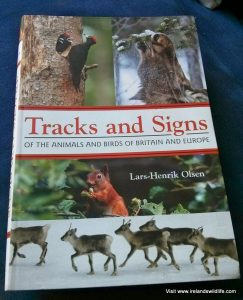 There are no two ways about it, a lot of our wildlife is incredibly tricky to see.
There are no two ways about it, a lot of our wildlife is incredibly tricky to see.
You can get lucky, of course. Occasionally birds, and even mammals, lizards or amphibians, will appear out of nowhere, seemingly oblivious to your presence as you marvel them in close proximity. These are, by and large, the exception rather than the rule. Most of the the time wildlife watching is about time, patience and knowledge. It’s about gaining an understanding of your subject, its habitat and its habits, and putting yourself in the right place, at the right time, in the right conditions as often as possible to maximise your chances of an encounter.
Even then the odds are often stacked against you: there will be plenty of times when you return home without a glimpse of your target species. Finding wildlife is hard — but the challenge and anticipation is a big part of the appeal, and playing amateur sleuth to work out what is around and where’s best to look for it is all part of the fun.
Luckily, finding and reading wildlife signs can be a lot easier than finding the wildlife itself, and they offer valuable clues that boost your chances of catching a glimpse of the animal you’re looking for — as long as you know what to look for. That’s where “Tracks and Signs of the Animals and Birds of Britain and Europe” by Lars-Henrik Olsen comes in.
Published by Princeton University Press, this is very attractive book that’s crammed full of photographs, illustrations and informative text designed to help you find and read the tell-tale tracks and signs left behind by the birds and mammals around you. That’s the first point to make… it is a book that focuses on birds and mammals. If you’re to track down reptiles or amphibians you’re going to be out of luck here.
For most people though, the bulk of the tracks and signs we’re going to encounter in the field will be left by either a bird or a mammal. The 175 species covered in this guide offers a good cross-section of the most commonly encountered animal tracks and signs in Britain, Ireland and continental Europe. The information contained will help you identify many of the tracks and signs you find down to species level, or at least to a particular taxonomic group of animals (for example, you may be able to identify goose prints in mud — but pinning down the species would be pretty much impossible).
Its a great asset — and will help you build a picture of the wildlife around you in any given location — but it does much more than that.
For me one of the great strengths of this book is that reading it — even just browsing through it — has heighten my awareness of what is around me. I always kept an eye out for tracks and signs — but since spending a bit of time with this book I find myself noticing much more — and referring back to it often when I’ve discovered something new to narrow down the options.
If I have a criticism it would be the chosen format for the book. It is first and foremost a field guide, but at just a bit larger than A5 size it’s a little bit too big to slip into a jacket pocket and carry around comfortably in the field. What I tend to do instead is take photographs of any tracks or signs I see using my phone, make any additional notes I think relevant, and then use the book as a reference guide when I get back. That system seems to work well enough, but there are times when carrying the book itself into the field would be preferable.
Who’s tracks are they?
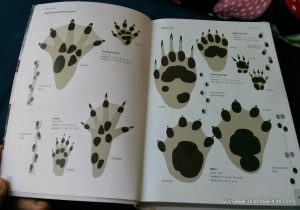 The book starts with perhaps the signs everybody notices first, and most want to identify: mammal tracks. Who among us hasn’t seen footprints in the mud or snow and wondered what made them?
The book starts with perhaps the signs everybody notices first, and most want to identify: mammal tracks. Who among us hasn’t seen footprints in the mud or snow and wondered what made them?
The illustrations of prints (showing front and hind feet where they differ) are, wherever possible, represented at their actual-size (obviously larger mammals like brown bear and elk are scaled down to fit the page). Alongside the prints is a really useful track sequence diagram showing the typical pattern of front and hind feet as the animal moves. A nice touch here is the inclusion of domestic animals like dog, cat, sheep, cattle, horse and goat for comparison.
The mammal track section is followed by a section on discarded antlers, and then bird tracks — which the author is at pains to point out can be very difficult to identify, but that identifying different family groups is relatively straightforward. Through illustrations, photographs and informative text he goes on to offer a guide to at least narrow down the potential species through size, gait and other track characteristics.
The universal calling card
Then it’s on to everyone’s favourite animal calling card: poo! Scat can be a really important indicator of what species are frequenting an area, and tends to be relatively easy to find. Size, shape, location, contents and other clues can help you to identify the depositor, and the book offers a great guide to commonly encountered carnivore, small mammals, large herbivores and birds.
Feeding and other signs
Animals often leave tell-tale signs where they’ve been feeding. From gnaw marks on tree bark to tooth marks on mushrooms, stripped pine-cones, nuts and fruit — all can offer valuable clues to what animals have been feeding in an area. There are sections on nests and dens, bird pellets, feathers and raptor feeding signs too. All in all it’s a pretty comprehensive overview of the sorts of things you’re likely to find, and a good general guide to identifying the type of animal, and in many cases the actual species of animal from the signs it leaves behind.
Species Profiles
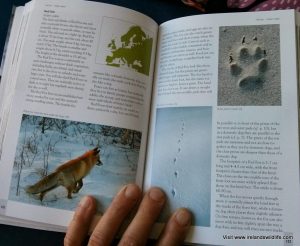 The second half of the book is dedicated to individual species profiles of the mammals whose tracks and signs you’re likely to encounter in Europe. They are wonderfully presented with excellent photographs and descriptions that obviously highlight the likely tracks and signs for each species. They complement and enhance the information in the first half of the book, and provides context to help you piece together the clues you find and pin down particular species.
The second half of the book is dedicated to individual species profiles of the mammals whose tracks and signs you’re likely to encounter in Europe. They are wonderfully presented with excellent photographs and descriptions that obviously highlight the likely tracks and signs for each species. They complement and enhance the information in the first half of the book, and provides context to help you piece together the clues you find and pin down particular species.
Conclusion
If you’re a budding wildlife detective and are keen to get a handle on the wildlife around you that you don’t actually see, this is a fantastic book to add to your natural history bookshelf.
Pulling together the huge array of tell-tale traces animals leave behind into a concise, useful guide was always going to be a challenge . In this book Lars-Henrik Olsen has done an admirable job — creating a reference that’s not only functional, but is also beautifully produced and wonderful to browse through at any time. I’d highly recommend a copy.
Thanks to Princeton University Press for submitting this title for review on Ireland’s Wildlife.
If you’re a publisher of Natural History books and would like to see your titles reviewed on Ireland’s Wildlife please get in touch using the contact form.



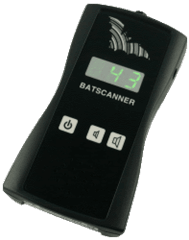
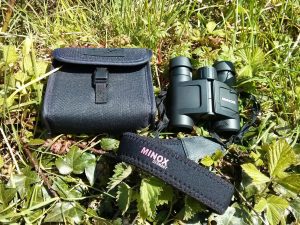





1 comment